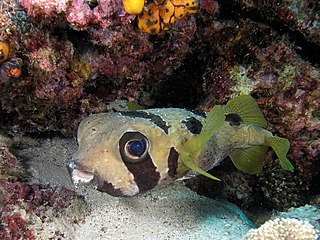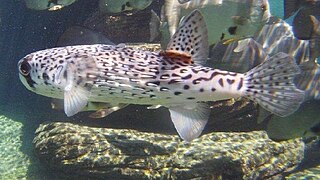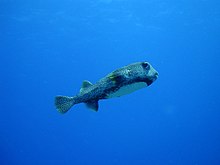
Tetraodontidae is a family of primarily marine and estuarine fish of the order Tetraodontiformes. The family includes many familiar species variously called pufferfish, puffers, balloonfish, blowfish, blowers, blowies, bubblefish, globefish, swellfish, toadfish, toadies, toadle, honey toads, sugar toads, and sea squab. They are morphologically similar to the closely related porcupinefish, which have large external spines.

Porcupinefish are medium-to-large fish belonging to the family Diodontidae from the order Tetraodontiformes which are also commonly called blowfish and, sometimes, balloonfish and globefish. They are sometimes collectively called pufferfish, not to be confused with the morphologically similar and closely related Tetraodontidae, which are more commonly given this name.

John Dory, St Pierre, or Peter's fish, refers to fish of the genus Zeus, especially Zeus faber, of widespread distribution. It is an edible demersal coastal marine fish with a laterally compressed olive-yellow body which has a large dark spot, and long spines on the dorsal fin. Its large eyes at the front of the head provide it with binocular vision and depth perception, which are important for predators. The John Dory's eye spot on the side of its body also confuses prey, which are scooped up in its big mouth.

Oxynotus is a genus of sharks in the order Squaliformes, commonly known as the rough sharks. It is the only extant genus in the family Oxynotidae. They live in deep waters in the Atlantic and western Pacific Oceans.

The second voyage of HMS Beagle, from 27 December 1831 to 2 October 1836, was the second survey expedition of HMS Beagle, made under her newest commander, Robert FitzRoy. FitzRoy had thought of the advantages of having someone onboard who could investigate geology, and sought a naturalist to accompany them as a supernumerary. At the age of 22, the graduate Charles Darwin hoped to see the tropics before becoming a parson, and accepted the opportunity. He was greatly influenced by reading Charles Lyell's Principles of Geology during the voyage. By the end of the expedition, Darwin had made his name as a geologist and fossil collector, and the publication of his journal gave him wide renown as a writer.

The black-blotched porcupinefish, also known as shortspine porcupinefish, is a member of the family Diodontidae. It is found in the tropical and subtropical waters of the Indo-Pacific on coral and rocky reefs and in inshore waters. Other names are the blotched porcupinefish and the brown-backed porcupinefish.

The spot-fin porcupinefish, also known as the spotted porcupinefish, black-spotted porcupinefish or simply porcupinefish, is a member of the family Diodontidae.

The long-spine porcupinefish, also known as the freckled porcupinefish, porcupine puffer, and porcupine pufferfish, is a species of marine fish in the family Diodontidae.

The slender-spined porcupine fish or globefish is a porcupinefish of the family Diodontidae, found in the waters of southern Australia, as far north as Port Jackson to Geraldton, Western Australia. It is most common in Port Phillip Bay and the coastal waters of Tasmania in shallow coastal waters and under manmade jetties. It is known to occur at a depth range of 1 to 70 m.

Cyclicthys is a genus of fish in the porcupinefish family, Diodontidae. Species in the genus are often known as swelltoads.

Ptychodus is a genus of extinct large durophagous (shell-crushing) lamniform sharks from the Cretaceous period, spanning from the Albian to the Campanian. Fossils of Ptychodus teeth are found in many Late Cretaceous marine sediments worldwide. At least 16 species are considered valid, with the largest members of the genus suggested to have grown up to 10 meters long. The youngest remains date to around 85 million years ago. A large number of remains have been found in the former Western Interior Seaway.

Caranx is a genus of tropical to subtropical marine fishes in the jack family Carangidae, commonly known as jacks, trevallies and kingfishes. They are moderate- to large-sized, deep-bodied fishes which are distinguished from other carangid genera by specific gill raker, fin ray and dentition characteristics. The genus is represented in the Pacific, Indian and Atlantic Oceans, inhabiting both inshore and offshore regions, ranging from estuaries and bays to deep reefs and offshore islands. All species are powerful predators, taking a variety of fish, crustaceans and cephalopods, while they in turn are prey to larger pelagic fishes and sharks. A number of fish in the genus have a reputation as powerful gamefish and are highly sought by anglers. They often make up high amounts of the catch in various fisheries, but are generally considered poor to fair table fishes.

Coccodus is an extinct genus of marine pycnodontid fish that lived during the Late Cretaceous. The various species had a pair of massive, curved spines emanating from the lower sides of the head, and one curved spine on the top of its head. Unlike most pycnodontids, Coccodus species had a comparatively long body, giving the living animals a superficial resemblance to a scaly chimaera.

Chilomycterus reticulatus, the spotfin burrfish, spotted burrfish, Pacific burrfish, spotfin porcupinefish or few-spined porcupinefish, is a species of fish in the genus Chilomycterus, which is part of the porcupinefish family Diodontidae.

Cyclichthys orbicularis, known commonly as the birdbeak burrfish among other vernacular names, is a species of marine fish in the family Diodontidae.

Squalomorphii is a superorder of cartilaginous fishes, generally characterized by lacking traits such as an anal fin, nictitating membrane, or suborbital shelves in the cranium. Squalomorphii sharks are also called squalea, or squalean sharks. There are about 163 living species in 11 families. Squalean sharks are divided into four orders: the Hexanchiformes, Squaliformes, Squatiniformes, and Pristiophoriformes.

Diodon eydouxii, commonly known as the pelagic porcupinefish, is a species of porcupinefish with a circumtropical marine distribution.

Pinguipes chilensis, commonly known as the Chilean sandperch, is a species of ray-finned fish in the family Pinguipedidae. It is found in the southeastern Pacific Ocean off the coasts of Peru and Chile.

Conchoderma virgatum is a species of goose barnacle in the family Lepadidae. It is a pelagic species found in open water in most of the world's oceans attached to drifting objects or marine organisms.

Dracopristis is an extinct genus of ctenacanth that lived around 307 million years ago, during the Pennsylvanian sub-period of the Carboniferous period. The fish had 12 rows of short, squat teeth, and an array of spines on its dorsal fins. The main differentiation between ctenacanthiformes and true sharks is that ctenacanthiform mouths are larger but less flexible than the true sharks. The spines of the holotype fossil are about 0.57 meters long, and the whole body was around 2 meters (6 ft) long.


























